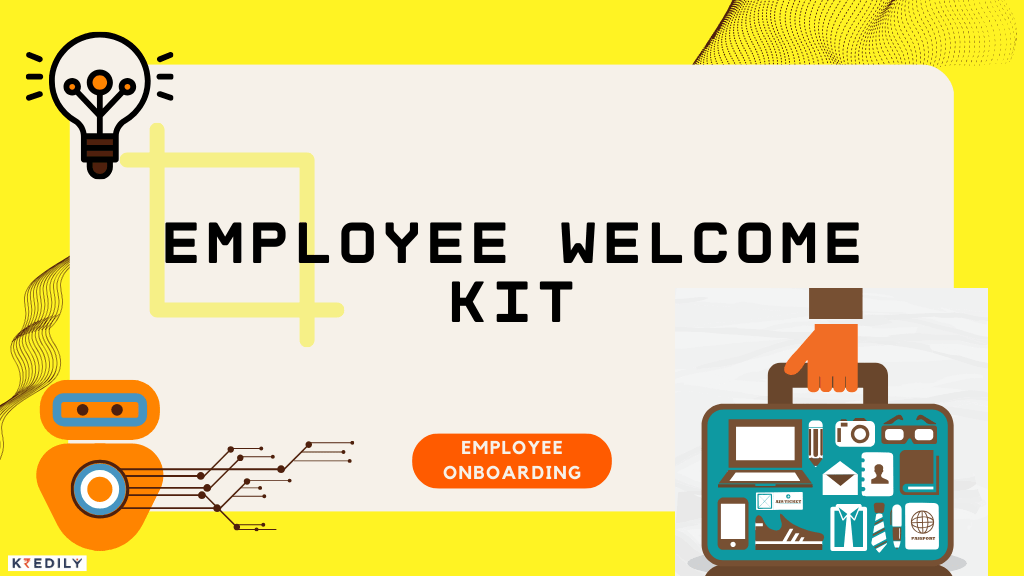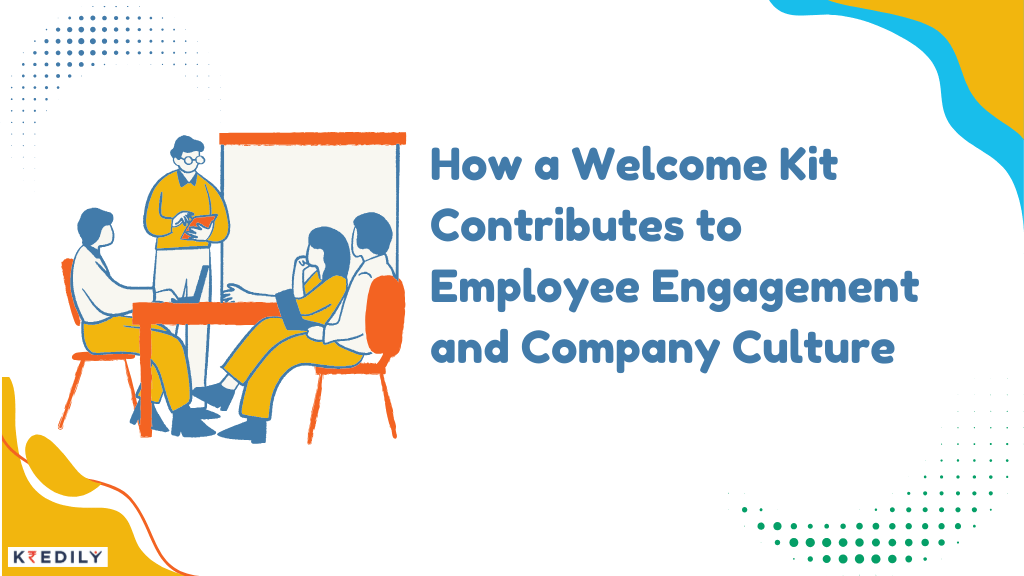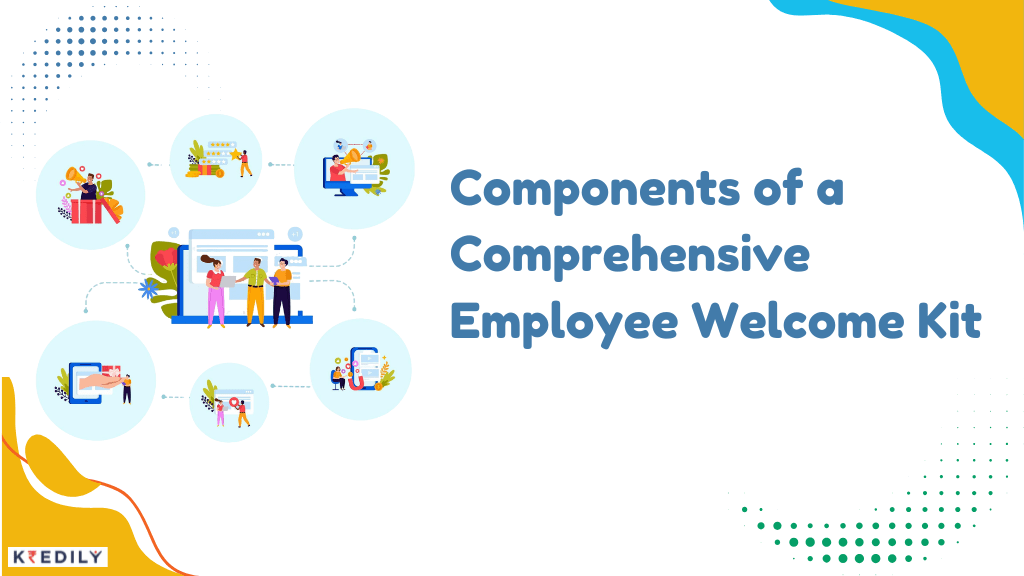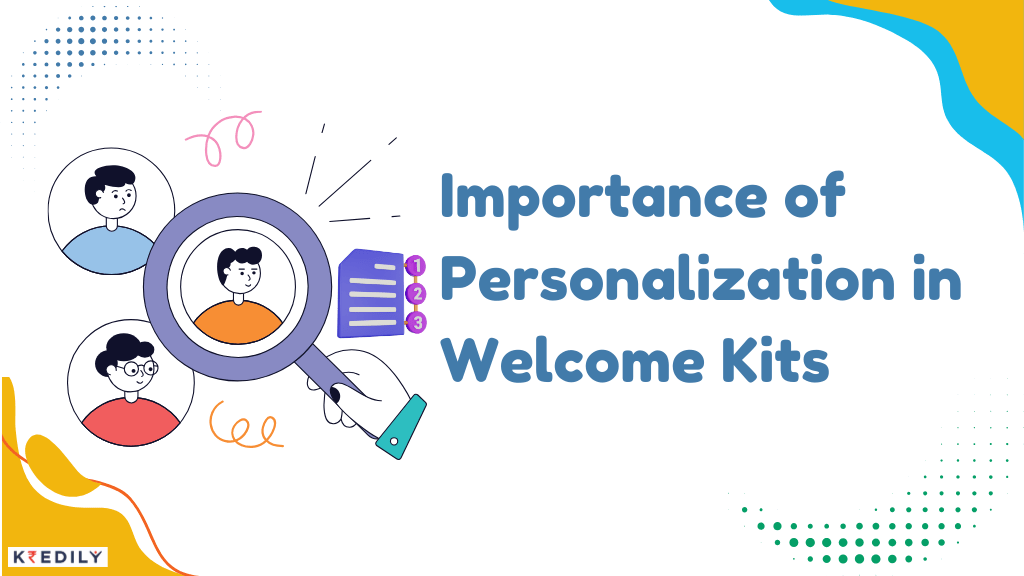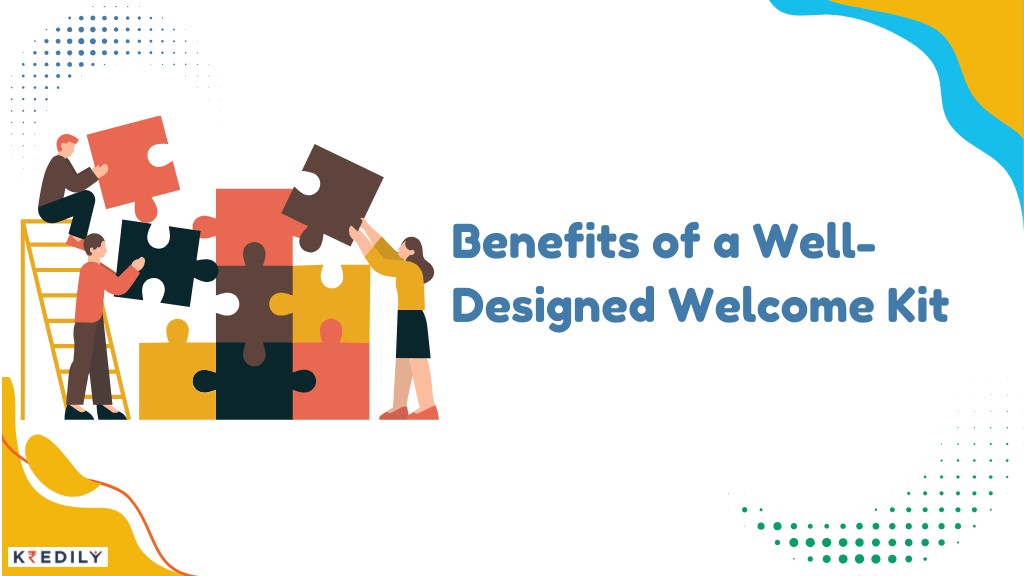Introduction to “Employee Welcome Kit”
An Employee Welcome Kit is a curated set of materials and gifts provided to new hires on their first day or shortly before they join an organization. It serves as an important introduction to the company, its culture, and its operational structure, giving new employees everything they need to feel welcomed, valued, and prepared to begin their journey with the company.
Definition and Purpose of an Employee Welcome Kit
The Employee Welcome Kit is a thoughtfully curated package to seamlessly onboard new hires, equipping them with essential tools and resources. It includes company-branded merchandise, documents detailing company culture and HR policies, and role-specific equipment. This kit fosters a positive, engaging introduction to the organization, setting the tone for a successful employee experience.
The purpose of an employee welcome kit is twofold:
- Practical Utility: To ensure that employees have the tools and knowledge to begin their work efficiently and effectively.
- Emotional Engagement: To help new hires feel welcomed, valued, and part of the company culture from day one.
Importance of a Well-Crafted Welcome Kit for New Hires
A well-crafted welcome kit is crucial because it sets the tone for the new hire’s experience. A thoughtful kit can greatly enhance a new employee’s first impression of the company, improving their initial engagement, motivation, and connection to the team. Here’s why it matters:
- Boosts Morale and Enthusiasm: Receiving a personalized and professional welcome kit shows the employees that the company values them, which can be incredibly motivating.
- Reduces Anxiety: Onboarding can be overwhelming, but a well-prepared kit can make the process smoother. By having the necessary materials and information readily available, new hires are less likely to feel lost.
- Enhances Retention: Employees who feel supported and integrated into the company are more likely to stay long-term. A positive first day, made possible by a thoughtful welcome kit, can improve employee retention.
- Strengthens Employer Brand: A well-thought-out employee welcome kit reflects a company’s commitment to its employees and enhances its reputation as an employer of choice.
How a Welcome Kit Contributes to Employee Engagement and Company Culture
The employee welcome kit is more than just a set of physical items; it plays a significant role in driving employee engagement and reinforcing the company’s culture. Here’s how:
- Fosters a Sense of Belonging: By including items that represent the company’s brand and values (e.g., company T-shirts, handbooks), the kit helps new hires feel like they’re part of something larger. This sense of belonging is critical to long-term engagement.
- Encourages Positive First Impressions: A well-crafted welcome kit reflects the organization’s commitment to its people, making a strong first impression that positively impacts employee motivation and satisfaction.
- Highlights Company Values: Including materials that showcase the company’s mission, vision, and core values helps new hires understand what the company stands for. It sets the stage for employees to align with the company’s culture and objectives, making them more likely to stay engaged.
- Creates an Ongoing Connection: The items and resources provided in the welcome kit can serve as a reminder of the company’s care and attention to detail, strengthening the bond between the employee and the organization as time goes on.
In conclusion, the Employee Welcome Kit is much more than a mere formality; it is an integral part of the onboarding process that impacts employee experience, engagement, and long-term retention. A well-planned and personalized welcome kit not only makes a great first impression but also serves as a foundation for building a meaningful connection between new hires and the company culture.
Components of a Comprehensive Employee Welcome Kit
A comprehensive Employee Welcome Kit is designed to provide new hires with everything they need to feel welcomed, prepared, and excited about their new role. A well-thought-out kit not only helps the new employee settle in quickly but also introduces them to the company culture, making them feel valued right from day one. Below are the essential components of an effective welcome kit:
1. Physical Welcome Items
Physical welcome items are tangible items that are often branded with the company logo or colors. These items are the first things a new employee sees and interacts with, making them an important part of their first impression.
Common physical items in a welcome kit include:
- T-shirts or Hoodies: Comfortable, branded clothing helps employees feel part of the team. It’s a great icebreaker and can help them feel connected to the company culture from day one.
- Mugs: A company-branded mug provides a personal touch and is practical for the new hire’s workspace.
- Stationery: Notepads, pens, and planners branded with the company logo give employees the tools they need for everyday tasks while reinforcing the brand.
These physical items help create a sense of belonging and pride in the new employee while also making them feel valued by the company.
2. Company Swag
In addition to functional items, many companies include swag in their welcome kits. These items not only serve as practical gifts but also as a way to promote the company brand.
Typical company swag includes:
- Notebooks: A high-quality branded notebook is a versatile item that employees can use for meetings, brainstorming sessions, or personal notes.
- Water Bottles: Eco-friendly, reusable water bottles are a popular addition, promoting health and sustainability.
- Tote Bags: A branded tote bag is a practical gift that employees can use to carry their personal belongings or groceries, further promoting the company logo.
- Branded Pens: Small but thoughtful, branded pens are useful in every office setting, reminding employees of their new workplace.
These items help build a sense of camaraderie and pride in the workplace while also serving as functional gifts.
3. Technology Setup
As part of the modern employee experience, companies provide new hires with the necessary technology setup to begin their role efficiently. These items are essential for day-to-day operations and allow new employees to hit the ground running.
Tech items in the welcome kit may include:
- Laptop or Desktop: Most companies provide a laptop or desktop computer with pre-installed software needed for the employee’s role.
- Mouse and Keyboard: High-quality peripherals like a wireless mouse and ergonomic keyboard enhance productivity and comfort.
- Mobile Devices: Depending on the job, mobile phones or tablets may be provided for remote work or communication needs.
- Company Login Credentials: Access to necessary software and systems is provided, including login credentials for internal platforms, email, and other communication tools.
Providing these tech items ensures that employees are well-equipped to begin their roles and work efficiently from the start.
4. HR Documents
One of the most important aspects of any employee welcome kit is the HR documents that contain all the necessary information for new hires to understand the company’s policies, benefits, and administrative processes.
Key HR documents to include:
- Company Policies: Clear, concise documents outlining workplace rules, expectations, and procedures help employees understand what is expected of them.
- Employee Handbook: This often includes details on company values, mission, and vision, helping the new hire align with the company culture.
- Benefits Information: Information about employee benefits, health insurance, retirement plans, and other perks should be easily accessible.
- Tax Forms: Necessary forms for payroll and taxes, such as W-4 or I-9, should be included to complete the administrative process.
Including these documents ensures that new hires are informed and prepared for the organizational and legal requirements of their new job.
5. Onboarding Schedule
An onboarding schedule is a roadmap of the new employee’s first few days or weeks at the company. This schedule helps new hires navigate the initial stages of their employment and prepares them for upcoming meetings, training sessions, and introductions.
What to include in an onboarding schedule:
- First Week Activities: A detailed breakdown of the first week’s activities, including introductions to key team members and training sessions.
- Meetings and Training: A list of required meetings, such as introductions to leadership, team members, and department heads, as well as training sessions on company software, tools, and systems.
- Mentorship/Team Introductions: Scheduling meet-and-greet sessions with key team members, a mentor, or a supervisor to help the new employee settle in and build relationships.
An onboarding schedule ensures that new employees know what to expect and can plan accordingly, reducing any potential anxiety about the unknown.
6. Personalized Gifts
Adding a personal touch to the welcome kit is one of the best ways to make a new hire feel appreciated and special. Personalized gifts can make a huge difference in terms of employee satisfaction and engagement.
Examples of personalized gifts include:
- Customized Items: These could be items like a nameplate for the desk, a personalized mug, or a company-branded shirt with the employee’s name.
- Personal Welcome Note: A handwritten or digital welcome note from the team or manager adds a personal touch, showing the employee that they are valued right from the start. Enhancing this with AI animations can make the gesture even more engaging and memorable, adding a modern and dynamic flair to the onboarding experience.
- Personalized Welcome Letter: A letter outlining the employee’s role, expectations, and the team’s excitement about their arrival helps them feel welcomed.
These personalized touches go a long way in ensuring that the new hire feels connected and appreciated right from the beginning.
Importance of Personalization in Welcome Kits
A personalized welcome kit can make a world of difference when it comes to employee onboarding. It shows new hires that the company values them, creating a strong first impression.
Tailoring the Kit to the Role or Department
Personalizing the kit according to the new hire’s role or department helps them feel immediately connected to their work environment. Whether it’s a branded notebook for the marketing team or a tech gadget for the IT team, role-specific items foster a sense of belonging and relevance.
Adding Personalized Touches
Including personalized items, such as name tags, role-specific gear, or even a handwritten welcome note, can make new hires feel special and valued. These small gestures go a long way in building rapport.
Customizing for Remote Employees vs. In-Office Staff
While in-office kits often include physical items, remote employees require a different approach. A digital welcome kit with virtual meeting links, team introductions, and access to resources is crucial for remote workers to feel engaged from day one.
Digital Employee Welcome Kits for Remote Employees
As remote work continues to grow, digital welcome kits are becoming an essential tool for businesses with distributed teams. These kits can provide a seamless transition for new hires, whether they are in the office or working remotely.
Overview of Virtual Welcome Kits
A digital welcome kit typically includes access to company software, onboarding documents, and virtual team introductions. It can be delivered through email or an internal portal, ensuring that remote employees have all the tools they need for success.
Benefits of Digital Kits for Remote Teams
- Instant Access: New employees can immediately access resources such as employee handbooks, HR policies, and training materials.
- Streamlined Onboarding: With virtual onboarding schedules and interactive introductions, remote employees can get acquainted with their role without delays.
- Consistency: Digital kits ensure that every remote employee receives the same resources, regardless of location.
Tools and Resources Provided
- Company login credentials are needed to access platforms like the intranet and communication tools.
- Access to important software, such as project management tools or HR platforms.
Virtual onboarding schedules and team meetings that help remote employees connect with their new colleagues.
Onboarding Process & First-Day Expectations
A smooth onboarding process is essential for new hires to feel comfortable and engaged. Here’s how a structured onboarding process can benefit your team.
Detailed Schedule for the First Day or Week
Providing a clear roadmap for the first day helps new hires know what to expect. This can include introductions, training sessions, and meeting key team members.
Introduction to the Company’s Mission, Vision, and Values
Introducing new hires to the company’s mission, vision, and values is crucial. It helps them align with the company’s purpose and see where they fit into the bigger picture.
Overview of Team Introductions and Initial Meetings
The first day should include introductions to team members and initial meetings. These interactions help new hires feel integrated and provide clarity about their role.
Setting Up the Workspace, Whether Physical or Virtual
Setting up the workspace is vital. For in-office employees, this includes arranging their desks and providing necessary tech equipment. For remote employees, this may involve ensuring they have the required software tools and access to virtual communication platforms.
Creating a Welcoming Atmosphere
The welcome kit plays a key role in creating a positive atmosphere for new hires.
How a Thoughtful Welcome Kit Improves the First Impression
A well-designed welcome kit sets the tone for the new hire’s experience. It demonstrates that the company cares about their comfort and success from the very first moment.
Making the New Hire Feel Part of the Team from Day One
The goal of a welcome kit is to make employees feel included and appreciated. Whether through personalized items or introductory team calls, creating a warm environment helps them quickly become part of the team.
The Role of the Manager and HR in Employee Onboarding
Effective onboarding involves not just the welcome kit but the support of HR and management through the best employee onboarding software.
How Managers and HR Teams Contribute to Onboarding
HR teams and managers help set clear expectations, offer support, and ensure that the new hire is equipped to succeed. Managers play a significant role by introducing the team and answering any job-specific queries.
The Importance of Feedback and Check-ins During the First 30 Days
Regular feedback and check-ins ensure that new hires are settling in well. It’s important for managers to provide constructive guidance and assess progress during the first 30 days.
Benefits of a Well-Designed Welcome Kit
A comprehensive and thoughtful welcome kit offers numerous benefits, ensuring that employees feel supported and engaged.
Enhances Employee Retention
A positive first experience leads to higher retention rates. A well-received welcome kit can significantly reduce turnover by making employees feel valued and part of the team.
Boosts Morale and Motivation
Starting a new job can be intimidating. A well-designed welcome kit helps boost morale by showing that the company cares about their success.
Sets the Tone for Company Culture and Values
Your welcome kit can also communicate your company’s culture and values. It should reflect your organization’s ethos, helping new hires understand what’s expected and how they will fit into the company culture.
Reduces Confusion and Makes the Transition Smoother
The clarity that a well-thought-out welcome kit provides reduces initial confusion, whether it’s about job responsibilities or workplace procedures. This enables the new employee to hit the ground running and feel confident in their role.
Best Practices for Distributing the Welcome Kit
A welcome kit is an essential part of the onboarding process, helping new employees feel valued and connected from the start. To maximize its impact, distribution should be carefully planned. Here are some best practices for distributing the employee welcome kit to ensure a smooth and welcoming transition.
1. Timing: When to Give the Kit
The timing of distributing the welcome kit plays a key role in the success of the onboarding process. Whether it’s on the first day, before the first day, or in advance for remote employees, choosing the right moment is crucial.
On the First Day
For in-office employees, distributing the welcome kit on the first day is a traditional but effective approach. The physical presence of the kit can create a sense of excitement and anticipation as the employee walks into the office, ready to dive into their new role.
Before the First Day
Providing the kit before the first day helps employees get familiar with company materials, systems, and processes in advance. This approach is especially useful for remote workers, allowing them time to set up their workspace and software tools before officially starting.
In Advance for Remote Workers
For remote employees, it’s often beneficial to ship the welcome kit a few days before their start date. This gives them ample time to unpack and get everything in place, ensuring they feel prepared and supported when they begin working.
2. Delivery Methods for Remote and In-office Workers
The delivery method plays a significant role in how employees perceive the company’s effort in onboarding. Here’s how to manage the distribution for remote and in-office workers.
For In-Office Workers
For employees working on-site, a physical delivery method is preferred. The kit could be waiting for them at their workstation or handed directly to them on the first day by HR or their manager. Including company-branded items, personalized notes, and role-specific materials enhances the in-person experience.
For Remote Workers
When it comes to remote employees, digital or physical delivery can both be effective. If sending physical items, ensure timely shipping so the kit arrives before the first day. For digital-only remote kits, consider including virtual onboarding schedules, links to essential software, and access to company tools like intranets or communication platforms.
3. Ensuring All Necessary Materials Are Included and Easy to Access
Whether you’re sending a physical or digital welcome kit, it’s important to make sure all necessary materials are included and easy for the new hire to access. Here’s how to ensure everything is well-organized:
Documents and Manuals
Include key company documents such as the employee handbook, tax forms, and company policies in both digital and printed formats. Make sure these materials are easy to locate, either via a clearly labelled digital folder or a physical binder.
Role-Specific Gear
Ensure that the kit includes items relevant to the new hire’s role. For in-office employees, this may include work tools such as a laptop, notepads, or office supplies. For remote workers, provide digital tools such as software licenses, login credentials, and access to virtual meetings or training schedules.
Onboarding Resources
Incorporate links to virtual onboarding schedules and training resources. Digital access to internal tools, communication channels, and a list of immediate tasks can help remote workers hit the ground running.
Personalized Touches
Adding personalized items such as a welcome note, name tag, or role-specific merchandise (like branded shirts, mugs, etc.) can help build a strong connection with the new hire, no matter where they are working from.
